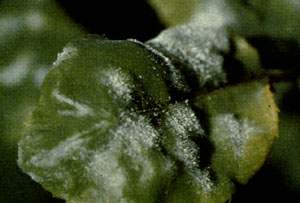

Click on image to view larger.
|
Powdery Mildew (Erysiphe cichoraceaum)
Most susceptible plants: begonia, chrysanthemum, gerbera daisy, kalanchoe, zinnia
Although most greenhouse crops can be infected by powdery mildew pathogens, each powdery mildew pathogen is specific to its host. The powdery mildew that infects gerbera daisy will not infect zinnia, etc. Powdery mildew is the most common disease of gerbera. Infection may start on the lower foliage and escape early detection if plants are not periodically monitored for this disease. Powdery mildew pathogens are readily disseminated in the air by air currents. Conditions that favor the development of powdery mildew diseases are moderate temperatures with high humidity. Some powdery mildew pathogens are enhanced by fluctuations between warm and cool temperatures but a relative humidity of 85% is generally needed for disease to develop.
Symptoms:
Powdery mildew diseases are very common to a number of greenhouse crops and are easy to diagnose by the development of an obvious white powder on the plant surface. An atypical brownish scab-like symptom also may occur.
Control:
Fungicides can be effective in managing powdery mildew diseases but take care to initiate applications at the first sign of infection and to rotate among effective fungicides. Include a systemic fungicide in the spray rotation.
|